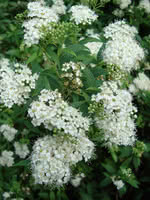Mon-Fri 9am - 5pm Mountain time
Black Locust vs White Meadowsweet
Robinia pseudoacacia
Spiraea alba
NOT AVAILABLE THIS SEASON - MIGHT RETURN
Black Locust is an attractive tree. Its distinctive leaves are made of about a dozen bright green leaflets. It also notable for its fragrant white flowers, which smell of citrus.
Black Locust can grow in many situations, but prefers dry areas with lots of sun. It is robust and is an excellent choice for establishing shade in dry, open areas.
Important note: Much of the Black Locust is toxic to humans and livestock, including seeds, bark, and leaves.
White Meadowsweet is a woody, deciduous shrub that begins to bloom in early summer with small white and pink flowers. Its foliage turns from a light green into an attractive golden-yellow later in the fall.
The White Meadowsweet, also known as Mead-Wort or Bride-Wort, is favored by birds and butterflies but is largely ignored by deer. They produce small brown berries in the summer, and while they are technically edible, they are not sweet and are more desired by wildlife.

